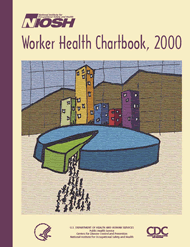Worker Health Chartbook, 2000
September 2000
DHHS (NIOSH) Publication Number 2000-127

More than 131 million people are employed in the United States. As we enter the new millennium, the U.S. workforce will be older and more diverse and will continue to shift from traditional heavy industry to services. Alternative work arrangements such as job sharing, part-time scheduling, and temporary or contingent work will become more common in response to rapid technological and economic changes. These changes will present new challenges to assuring the safety and health of Americans in the workplace.
Preventing occupational injuries and illnesses depends on our ability to quantify and track them. Through occupational safety and health surveillance, we can provide ongoing and systematic collection, analysis, interpretation, and dissemination of data for the purposes of prevention. Surveillance increases the effectiveness of prevention activities by targeting them to industries, workplaces, and occupations that have the greatest needs. Surveillance also expands knowledge about which prevention programs are effective.
Worker Health Chartbook, 2000 [PDF - 19 KB]
- Page last reviewed: June 6, 2014
- Page last updated: June 6, 2014
- Content source:
- National Institute for Occupational Safety and Health Education and Information Division


 ShareCompartir
ShareCompartir